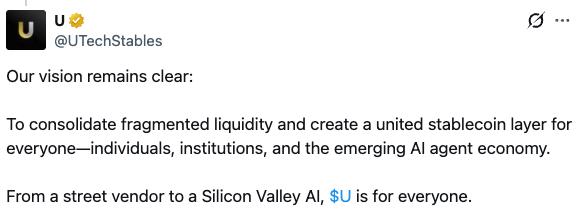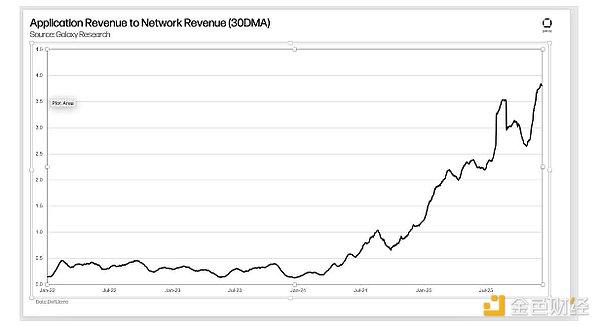Compiled by: Mars Finance, Eason
summary
Ronin is an EVM-compatible Layer-1 blockchain optimized for NFTs and games. The network aims to build a Play-to-Earn (P2E) gaming ecosystem that is fully owned and supported by the community.
Ronin has strong appeal among both Web2 and Web3 gamers. As of this writing, the number of daily active addresses (DAA) peaked at 1.6 million in 2024. Notable games driving this trend include Pixels, Apeiron, and Axie Infinity Universe (the most popular NFT game by transaction volume).
Ronin migrated to the delegated proof-of-stake (DPoS) consensus mechanism after the bridge hack in March 2022. Sky Mavis, the gaming studio behind Ronin, also expanded the number of validators from 9 to 24 and absorbed independent enterprise operators.
Sky Mavis has partnered with the popular Ragnarok game IP and 0x& to bring Ragnarok: Monster World to its ecosystem in Q3 2024.
Sky Mavis plans to integrate the zero-knowledge Ethereum Virtual Machine (zkEVM) to allow games to permissionlessly launch and operate their own layer 2 chains on the Ronin network using Polygon CDK.
Introduction to Ronin Blockchain
Games on the Ethereum network face several limitations. As the number of users on the network has steadily grown, so have transaction volumes and gas payments. Increased competition for block space has led to network congestion. High gas prices and scalability issues have made on-chain gaming transactions economically infeasible, undermining player acquisition and retention.
The Ronin blockchain is designed to solve these scalability issues and facilitate the onboarding of hundreds of millions of future gamers to blockchain-based platforms. It was originally developed by gaming studio Sky Mavis in 2021 for the popular P2E game Axie Infinity. Now, Ronin is an EVM-compatible Layer-1 (L1) blockchain optimized for gaming and NFTs.
Currently, Ronin’s most popular game by daily active wallets (DAW) is Pixels, a free-to-play farming simulator. The game migrated to Ronin from Polygon in October 2023. To date, Ronin has processed over $11.4 billion in decentralized exchange (DEX) volume and over $4.3 billion in NFT volume on Katana.
Ronin History
The story of Ronin begins with the story of the popular P2E Web3 game Axie Infinity. Axie Infinity's founders, Trung Nguyen, Aleksander Leonard Larsen, and Jeffrey Zirlin, met while playing Cryptokitties, one of the earliest games to use blockchain technology. The trio saw an opportunity to apply this innovation to solve a fundamental problem of traditional games: the economic value created by players is primarily retained by the platform owners rather than the players themselves.
To solve this problem, they founded the game studio Sky Mavis in 2018 and developed Axie Infinity, a game where players can own and benefit from in-game assets. Their first big step was the pre-sale of Axie NFTs in April 2018, where players could adopt Axies and receive customized rewards when Axie Infinity launched. This laid the foundation for the Ronin ecosystem, where player ownership is at the core.
As Axie Infinity's popularity continued to grow, the team launched Axie Infinity's native token, AXS, on Binance in November 2020. The token was originally released as an ERC-20 on Ethereum, providing governance, staking, in-game features, and a share of the game economy. However, as the game's popularity on the Ethereum network continued to grow, users began to experience poor performance due to high gas fees and network congestion. The Axie Infinity founders created Ronin to solve issues with time, scalability, and player experience on the Ethereum network.
Sky Mavis launched the network testnet on December 23, 2020, and the mainnet on February 1, 2021. In April 2021, Axie Infinity officially migrated from Ethereum to the Ronin Layer-1 blockchain. After the transition, the AXS staking program was launched in September 2021, allowing Axie Infinity players to earn rewards and participate in game governance. This enables players to own and control the direction of the game, creating a gaming platform that transfers value from platform owners to players. At the height of Axie Infinity's popularity, the game had over 1 million on-chain and 2 million off-chain daily active players.
Despite a smooth start, on March 29, 2022, Ronin Bridge was hacked, resulting in the theft of 173,600 ETH and 25.5 million USDC, worth over $600 million at the time of the hack. The hack was revealed a week later when a user attempted to withdraw 5,000 ETH but found that it was unable to do so.
The hacker took control of the private keys of four Sky Mavis validator nodes and the Axie DAO node by exploiting a vulnerability in the network. This access was achieved due to a backdoor bug in the gasless RPC node, which allowed the hacker to obtain the signature of the Axie DAO validator. This backdoor existed because the Axie DAO validator had previously been whitelisted to allow free transactions during periods of peak network activity. Although this whitelisting ceased in December 2021, the IP address of the Axie DAO validator remained on the allow list, allowing the hacker to enter. Since only nine validator nodes were running during the attack, the hackers, who are rumored to be from the North Korean Lazarus group, controlled the majority of the nodes and could pass fake withdrawals.
Binance recovered $5.8 million in funds related to the hack, and Chainanalysis recovered $30 million. In June 2024, Økokrim, the Norwegian government's anti-financial crime agency, announced the return of another $5.7 million and the freezing of $40 million in hacked funds.
Since the bridge hack, Ronin has increased the decentralization of the network by migrating to DPoS, forming strategic partnerships with independent businesses to operate validators, and introducing rotating validators. Ronin has also welcomed new Web2 and Web3 games and studios, expanding the ecosystem beyond the core Axie Infinity series. As a result, the network has made a dramatic comeback in 2024, with Ronin having a wider collection of games than ever before.
Ronin Technology
Ronin initially adopted the Byzantine Fault Tolerant (BFT) Proof of Authority (PoA) consensus mechanism, in which Sky Mavis designated a limited number of validators. A limited number of validators enables transactions to be verified faster, thereby increasing throughput. However, it also brings a major flaw: the system places a high degree of trust in the validator set, and if the validators collude to do evil, a single point of failure will be created.
Therefore, Ronin adopted BFT Delegated Proof of Stake (DPoS) in 2023. This consensus mechanism allows anyone to register as a validator candidate with a minimum staking requirement of 250,0000 RON (bridge operators need to stake an additional 100 RON), which is worth about $390,000 at the time of writing. Under DPoS, validator candidates compete to obtain delegated RON from token holders. The 10 candidates with the highest total amount of staked and delegated RON tokens are selected at 00:00 UTC every day to serve as standard validators and contribute to consensus.
Standard validators validate transactions, generate new blocks, and receive operator rewards. These rewards are paid in the form of RON tokens, which come from the "reward" allocation (25% of the total token supply) and the transaction fees included in each block. Delegators receive a portion of these rewards, minus a commission rate of 5% to 20%, which is paid to standard validators.
In addition to the 10 standard validators, Ronin also has 12 management validators who contribute to the consensus. These validators are selected through on-chain governance and are operated by trusted independent companies. Notable management validators include Google Cloud, Nansen, Dapp Radar, and Stablenode. Token holders can still delegate their RON to management validators to receive rewards, but this will not affect the selection of validators.
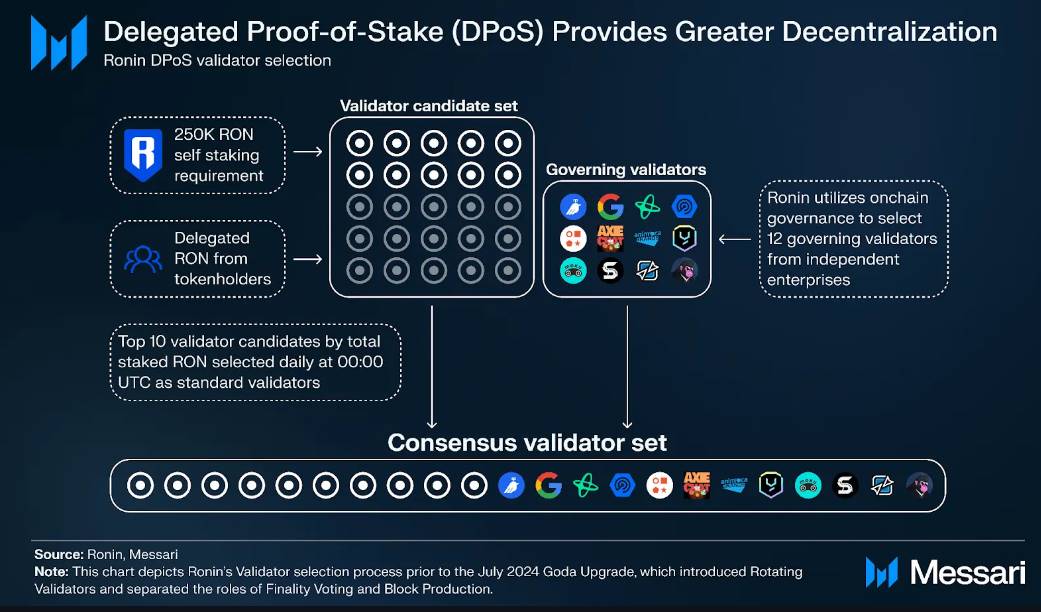
In July 2024, Ronin launched the Goda upgrade to enable all active validators to contribute to the consensus mechanism and receive rewards. Under the previous DPoS version, only the top 10 validator candidates could contribute to the consensus mechanism and receive rewards, incentivizing token holders to delegate RON to these top candidates to continue to receive rewards. As a result, the number of people delegating to other validators would decrease, and new validator candidates would be reluctant to participate due to the high staking requirements. Therefore, the previous DPoS version centralized the network by concentrating the delegated RON among the top 10 validator candidates.
The Goda upgrade solves this problem by separating the final vote and block production tasks. All validators participate in the final vote and receive 85% of the rewards, with voting power proportional to the amount of RON staked. For block production, Ronin introduces rotating validators to receive the remaining 15% of the rewards. Every epoch (approximately 10 minutes), 10 validator candidates are randomly selected to produce blocks. This selection uses a verifiable random function (VRF), which takes into account the total RON of each validator candidate. 12 management validators also produce blocks, but they do not rotate.
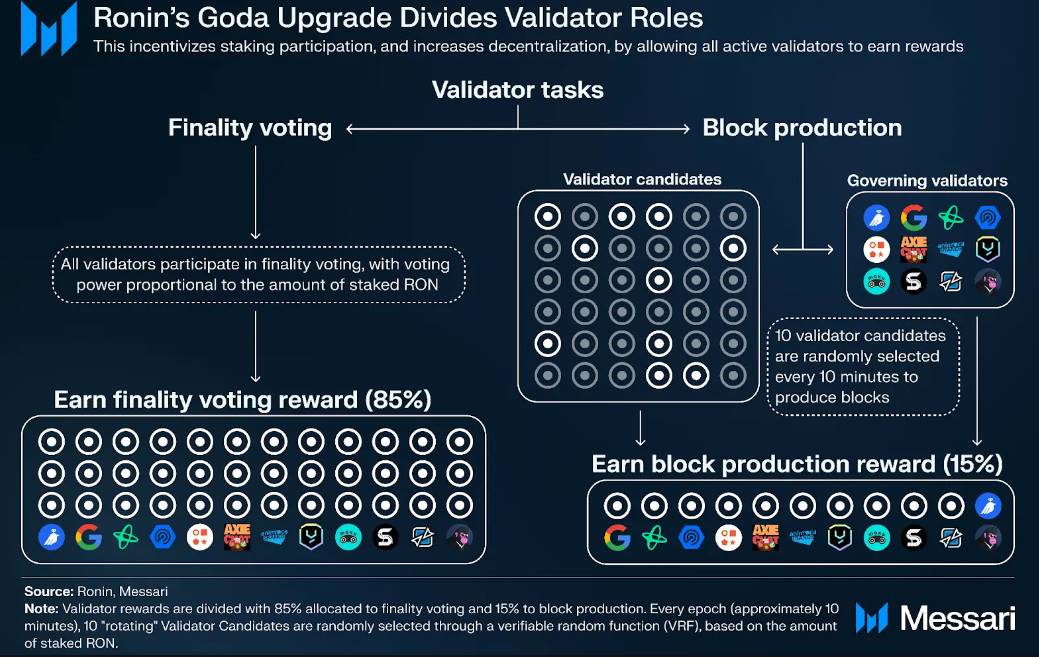
Validators and bridge operators who behave maliciously will be punished, with the severity of the punishment varying depending on the severity of the violation. If a validator behaves maliciously and is punished, the delegator will not receive rewards for the day, but the delegated tokens will not be affected. This promotes responsible network participation.
For double-signing validators, the validator will be jailed for 2^63 -1 blocks and cannot become a validator in the future. During the jailing period, the validator will not receive commissions and staking rewards. In addition, the validator will be slashed for the minimum amount of self-delegated RON staked.
There are several levels of slashing penalties for unavailable validators:
For Tier 1 validator slashing penalties, if a validator misses more than 100 blocks a day, they will not receive commissions or staking rewards.
For the Level 2 validator penalty, if a validator misses more than 500 blocks in a day, the validator will not receive commissions and staking rewards for that day. In addition to being slashed 1,000 self-delegated RON and jailed for 57,600 blocks (about 2 days), the validator is also banned from joining the validator set during the jailing period.
For the Level 3 validator slashing penalty, if the validator misses more than 100 blocks on the same day, the validator will be slashed 1,000 self-delegated RON. In addition, the validator will be jailed for 57,600 blocks (about 2 days), the rewards after being released from jail will be cancelled, and the validator cannot be released.
Similarly, for unavailable bridge operators, there are different levels of slashing penalties depending on the severity of the violation:
For Tier 1 operators, if a bridge operator misses more than 10% of votes in a day, that operator will not receive bridge rewards.
For the slashing penalty for secondary operators, if a bridge operator misses more than 30% of votes in a day, that operator will not receive any rewards for that day.
Each validator also needs to run a bridge. Standard validators use the Ronin Bridge to confirm deposits and withdrawals of token transfers between Ronin and other EVM-compatible networks. The Ronin network also includes non-validator nodes and archive nodes. Non-validator nodes are full nodes that do not participate in the consensus mechanism but sync with the ledger state and monitor the network. Applications use these nodes to query the blockchain, send transactions, and execute smart contracts. Archive nodes store more information than full nodes and retain all historical data from the blockchain. The corresponding data is much denser than that stored by validator and non-validator nodes and is mainly used by services such as block explorers, wallet providers, and blockchain analysis.
Token Economics
RON Overview
Ronin's native token RON is used for security and anti-Sybil attack (validator and delegator staking), as well as resource consumption (transaction fees and smart contract execution). The total supply is fixed at 1 billion RON.
Initial Allocation
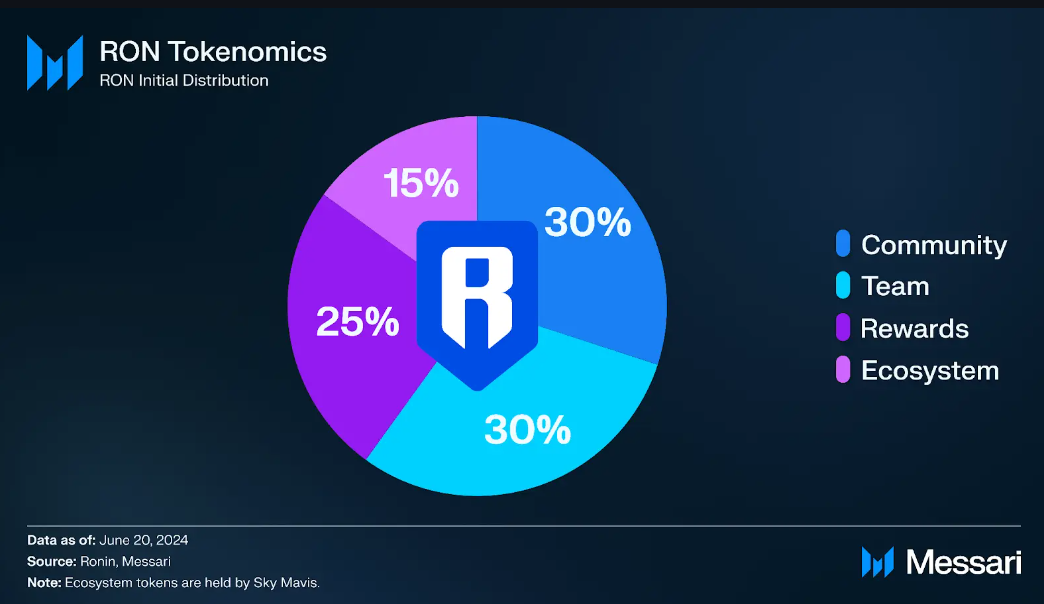
The initial token supply is divided into four main allocations: 30% to the community, 30% to the team, 25% to staking rewards, and 15% to the ecosystem fund. RON tokens are unlocked continuously, not in blocks. Unlocking begins on January 27, 2022, and if every unlocked token is issued, the maximum supply can be unlocked after 108 months or 9 years.
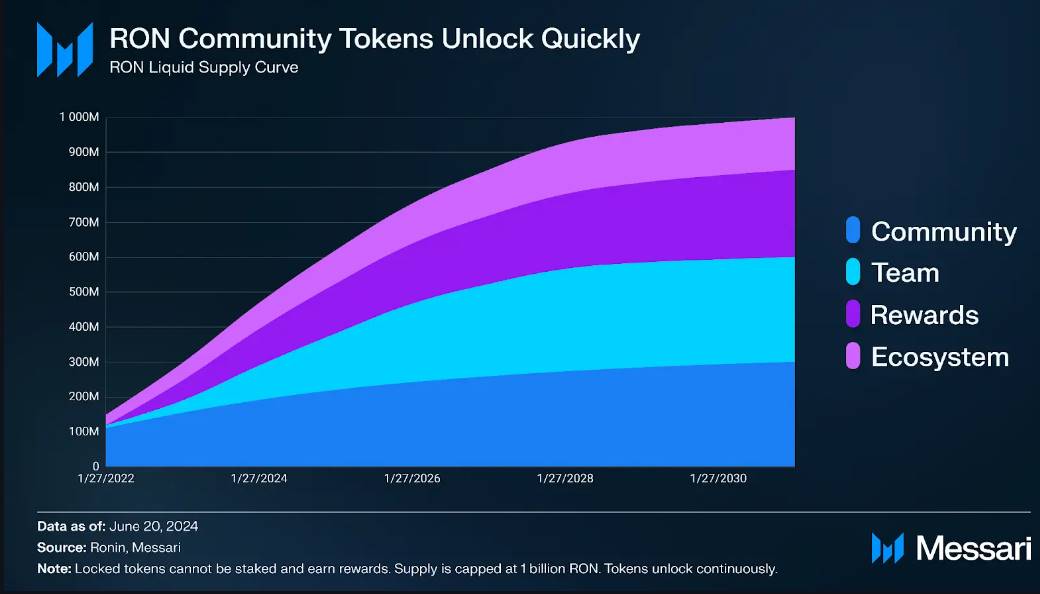
RON has several different useful functions in the Ronin ecosystem:
Medium of Exchange: RON is the payment currency for games, dApps, and NFT marketplaces on Ronin, and is paired with every token on the native DEX Katana.
Gas Fee: RON is used to pay for transactions on Ronin.
Staking: Users can stake or delegate RON to validators to participate in the DPoS consensus mechanism and receive rewards. These tokens come from the "reward" allocation (25% of the token supply) and transaction fees. Since the Goda upgrade, 85% of these rewards are distributed to all validators participating in the final vote, and 15% are distributed to validators selected for block production in each period. The delegator receives all rewards, minus a 5%-20% commission, which goes to the validator. As of June 20, 2024, this income is paid in RON with an annual interest rate between 10%-13%.
Game Revenue and Payments: Game studios on Ronin often integrate RON into their games as a primary source of revenue, including in-game purchases, actions, and NFT minting.
Special Incentives: RON token holders and stakers receive airdrops, whitelisting opportunities, and token launchpad allocations for projects built on the Ronin network.
In the future, RON token holders will be able to directly participate in governance, deciding how Ronin's treasury is used. However, this feature is not yet live. The treasury accumulates 0.5% fees from swaps on Katana and NFT sales on the Mavis marketplace, and is intended to support the growth of the broader ecosystem. Currently, only governance and standard validators vote on proposals on behalf of RON delegators.
Networking activities
usage
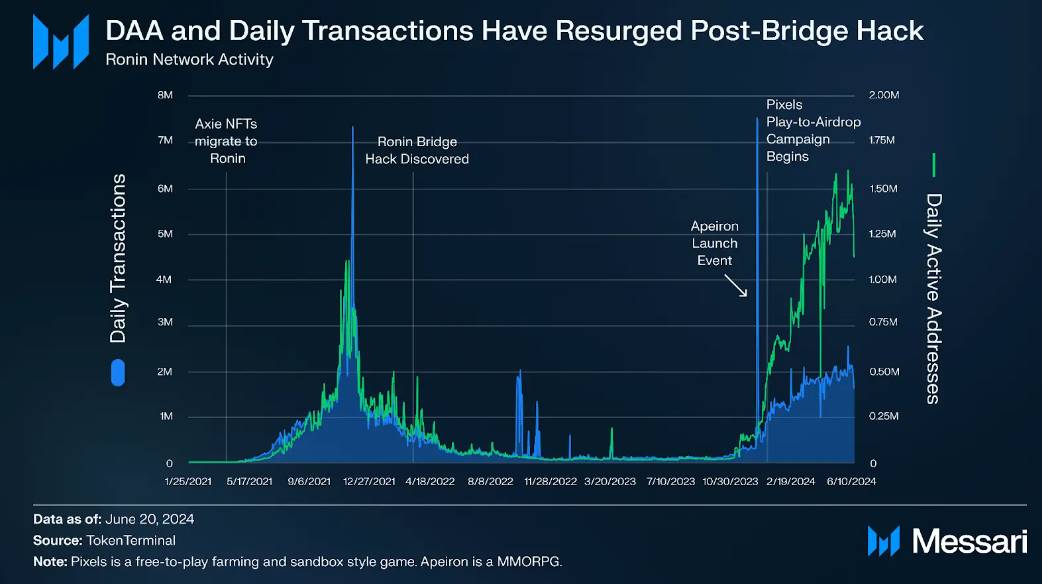
When Axie Infinity announced the migration of its NFTs to Ronin on April 28, 2021, network activity increased rapidly. At the time, Ronin had only 361 DAA and 10,600 daily transactions. Two months later, on June 28, 2021, these metrics surged to 32,800 DAA and 256,900 daily transactions, an increase of 8,986% and 2,324%, respectively. Since then, Ronin has continued to grow, reaching a peak of 1.1 million DAA and 7.3 million daily transactions in November 2021.
The influx of new players began to put pressure on the network, prompting Sky Mavis to whitelist Axie DAO to validate transactions - a decision that ultimately led to the March 2022 hack. Axie Infinity frenzy declined in 2022 due to overfarming and a rebalancing of in-game items, causing the game to become less profitable. The March 2022 Ronin bridge hack further solidified this decline. As a result, activity on Ronin dropped significantly throughout 2022, from 311,200 DAA and 972,000 daily transactions on January 1, 2022, to 10,300 DAA and 57,200 daily transactions on January 1, 2023.
However, network activity rebounded in late 2023 and early 2024, led by key partnerships with Sky Mavis, including new games such as Apeiron and Pixels. Daily transactions on Ronin surged from 370,000 on December 17, 2023 to 7.5 million on December 18, 2023, as the game Apeiron migrated from Polygon and launched. Apeiron is a unique game that blends simulation, real-time strategy, and action role-playing elements. Players take on the role of God, managing a planet, raising its inhabitants (called Doods) and engaging in battles - all while owning and trading in-game NFT assets. Apieron welcomed players to Ronin with an official launch event, which included daily login rewards, NFT mints, and game demos.
Pixels is another game that migrated from Polygon to Ronin in October 2023. Pixels is a massively multiplayer online (MMO) game that combines farming, exploration, and community building into an open world game. The game supports NFTs Farm Land and Pixel Pet NFTs on the Mavis Market and OpenSea markets. Pixels launched the Play-to-Airdrop event Season 2 for its in-game token PIXEL in January 2024. Players complete tasks to earn badges to be added to the leaderboard. In the token generation event, the top players will be rewarded with 250 million PIXEL.
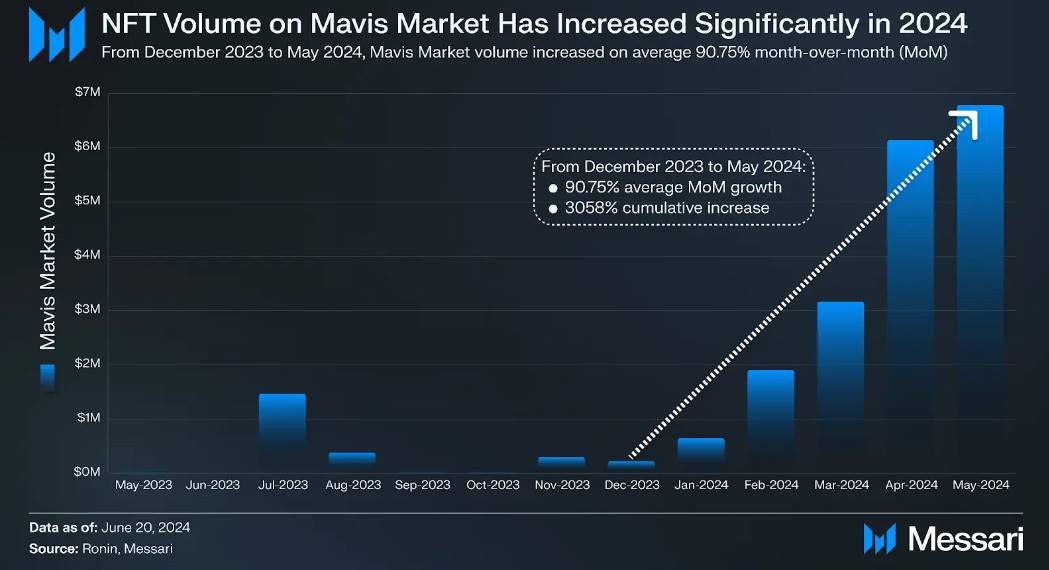
Ronin’s recovery in 2024 can be seen from the significant increase in NFT trading volume on Mavis Market, Sky Mavis’ official NFT marketplace. NFT trading volume on Mavis Market increased from $215,000 in December 2023 to $6,775,000 in May 2024, an average month-on-month increase of 90.75%. This means a cumulative increase of 3,058% over the same period.
Security and decentralization
Prior to the Goda upgrade, the Ronin network had 22 active validators, a number that has now increased to 24 with the implementation of rotating validators. The Nakamoto coefficient is a measure of the decentralization of a proof-of-stake network. It represents the minimum number of independent entities that control more than one-third of the network's staked native assets. Ronin's Nakamoto coefficient is 7, indicating that the network is more decentralized than other proof-of-stake networks, especially MultiverseX (6), Polygon (4), and Ethereum (1).
A total of 209 million RON (US$490 million as of June 20, 2024) has been staked, accounting for 62.3% of the circulating supply. Locked tokens cannot be staked and receive rewards.
Ecosystem
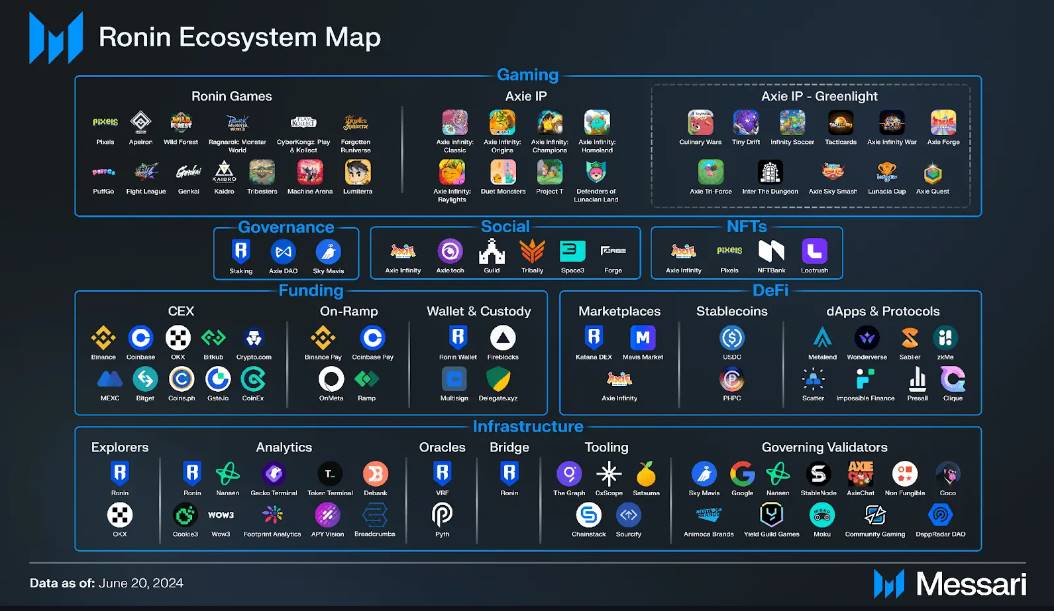
Games and NFTs
Ronin's gaming ecosystem emphasizes player ownership. Therefore, NFTs are an important part of this mission. Mavis Market is Sky Mavis' official marketplace for trading NFT collectibles outside of Axie IP. The most popular collectibles on Mavis Market include CyberKongz Genkai and Apeiron Planets, with cumulative trading volumes of 1.1 million and 865,000 RON respectively.
Axie Infinity remains the most traded NFT series on Ronin, with a cumulative trading volume of $4.3 billion. However, it is traded on the Axie Marketplace, not the Mavis Marketplace. Apeiron and Spark Suits Edition 01 (from the game Kaidro) are the top three series ever traded on Ronin, but are far behind with cumulative trading volumes of $3.2 million and $2.7 million, respectively.
The Ronin ecosystem currently consists of 12 games on the Mavis Hub platform, the official app that provides access to all Sky Mavis games. It features early games and community-created games that have received Sky Mavis support. In August 2023, Axie Infinity launched Mavis Hub Greenlight, a new home for game developers to share early versions of their Axie games with players directly on the Mavis Hub desktop app. Players can vote for their favorite early games and provide feedback to builders who want to officially launch their products. This is an expansion of the original Axie Builder's Program, which launched in April 2022, where community developers can apply to receive funding and support for games related to the Axie Infinity series. The latest game to launch on Mavis Hub Greenlight is Axie Forge, released in June 2024. Axie Forge is a casual idle sports game inspired by the Axie IP, where players can train their Axies through mini-games to upgrade them.
Ronin is home to a series of additional games outside of the Sky Mavis platform. Notable titles include Pixels and Ragnarok: Monster World, which is expected to be released in the third quarter of 2024.
Game developers who want to release games on Ronin must first undergo Sky Mavis's rigorous review process before they can be deployed. This ensures that the project is closely integrated with the ecosystem and prevents spam. By choosing to build on Ronin, developers can access the full set of Solidity development tools brought by EVM compatibility, such as Remix, Truffle, and Hardhat. In addition, developers can also access Sky Mavis's SDK and API, which can be smoothly integrated with Ronin's current products and services, including Ronin Wallet, Ronin Name Service, App Tracking, and Ronin JSON-RPC Node. The Ronin Developer Console is the central hub for accessing Ronin documentation and APIs.
Several of Ronin’s most critical developer primitives are designed to support growth and help projects raise funds to build out their gaming ecosystems. Ronin Launchpad, powered by Impossible Finance, enables studios to publicly sell a variety of assets. In March 2024, the popular Ronin game Apeiron successfully launched its token, APRS, through the app, raising over $3 million from over 11,500 participants. Mavis Store is the official marketplace for Sky Mavis to purchase in-game currency and assets. Game developers can integrate with the app to instantly access the app’s large user base and simplify complex asset lists. Several games currently leverage the platform to support in-game purchases, including Axie Quest, Wild Forest, and Ragnorak: Monster World. One notable series that recently launched on the platform is Moki Genesis. Participants can mint an egg to hatch a Moki character. All 8,888 NFTs sold out in about 2 hours.
DeFi
Decentralized finance on Ronin mainly consists of key infrastructure that supports on-chain games and NFT applications. One of the most important protocols is Katana, Ronin's native DEX. The platform provides three services: providing liquidity, monitoring analysis, and exchange.
Providing liquidity: Users can deposit into liquidity pools to provide trading liquidity. Depositors receive LP tokens and receive rewards generated by trading fees. As of June 20, 2024, USDC-RON and AXS-RON liquidity pools have the highest APRs of 33.68% and 43.49%, respectively. WETH-RON and USDC-RON liquidity pools generate the most LP fees.
Monitor analytics: Users can monitor analytics on the Katana dashboard.
Swap: Users can swap supported ERC-20 tokens such as Ronin (RON), Aprerios (APRS), Pixel (PIXEL), Axie Infinity Shard (AXS), Smooth Love Potion (SLP), and Yield Guild Games Token (YGG).
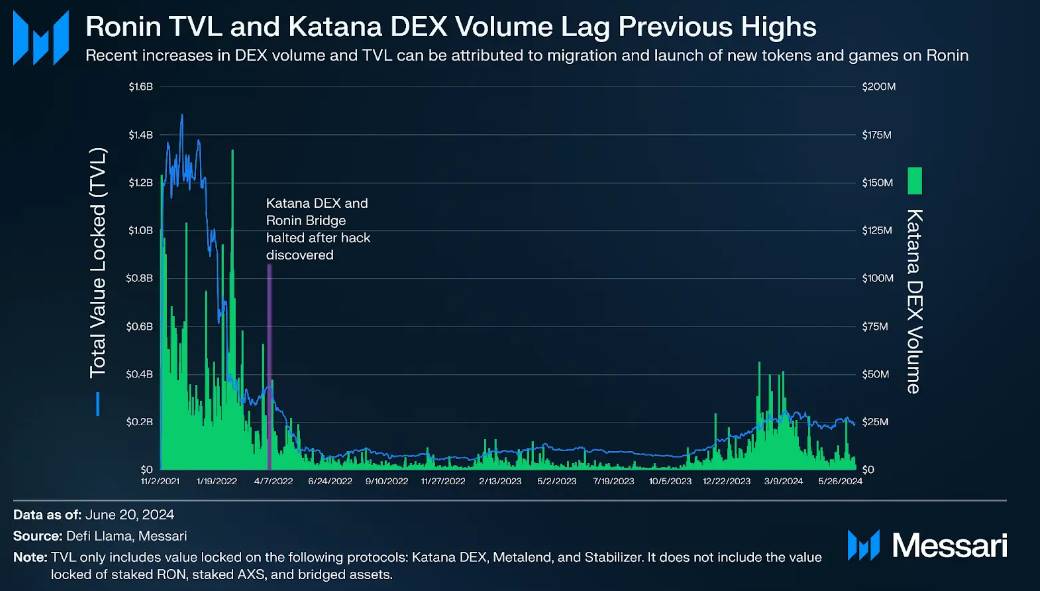
Katana’s TVL reached an all-time high of $1.49 billion on December 4, 2021, and DEX volume peaked at $175.77 million on February 10, 2022. This coincided with the peak of Axie Infinity, when AXS and SLP were heavily traded assets. Following the bridge hack, TVL on Katana dropped significantly. On May 12, 2022, TVL fell below $100 million and remained at that level until April 14, 2023, when it briefly rose above $100 million. On December 4, 2023, TVL on Katana surpassed $100 million again and has remained above that level since then. The recent growth in TVL and DEX volume is primarily due to the introduction of new tokens on Katana. As of 2024, Ronin has doubled the number of assets supported on Katana to 12 with the introduction of PIXEL, BANANA, YGG, APRS, ANIMA, and PHPC.
A key addition to Katana is the Philippine Peso stablecoin (PHPC). PHPC is supported by centralized cryptocurrency exchange (CEX) Coins.ph and is fully backed by cash and cash equivalents in Philippine bank accounts. The new stablecoin has been approved by the Bangko Sentral ng Pilipinas (BSP) and will be piloted exclusively on Ronin. In addition, PHPC is supported by the BSP’s regulatory sandbox framework. This is a major milestone for Ronin, making on-chain gaming more accessible to players in the Philippines and the Asia-Pacific region.
Another key DeFi protocol on Ronin is MetaLend. MetaLend enables borrowers to obtain overcollateralized loans in yield-producing assets without giving up custody. This is achieved through MetaLend’s valuation engine, which constantly recalculates the value of assets to ensure that they meet the protocol’s risk parameters. Borrowers provide collateral (staked AXS, staked RON, and Axie Land NFTs) to Metalend. Lenders stake WETH, RON, or USDC in the protocol’s lending pools and receive receipt tokens to track their deposits and interest earned. As of June 20, 2024, lenders’ APRs range from 1.4% to 12.1%.
Borrowers are subject to a 1% fee on their staked AXS and RON returns, which are automatically compounded daily. Borrowers can withdraw up to 30% and 50% of the current value of supported NFTs and tokens. Loans on MetaLend do not have a clear repayment period. However, if the value of the collateral drops or the interest accumulated exceeds the maximum LTV, the protocol will liquidate the assets to repay the loan.
Additionally, if a borrower exceeds their borrowing limit, MetaLend will list their collateral for sale at a 10% liquidation discount, allowing liquidators to repay up to 10% of the loan at a time. Any excess from the sale of larger assets (minus gas fees) will be returned to the borrower. This liquidation strategy helps MetaLend reduce risk during market crashes. As of June 20, 2024, MetaLend's TVL is $1.37 million.
Roadmap
Technical improvements
Over the past few months, Ronin has undergone significant technical improvements. In May 2024, Ronin partnered with zkMe to integrate its identity oracle into the chain, enabling novel privacy and security solutions. zkMe leverages zero-knowledge proofs to verify user credentials without processing personal information. This collaboration will provide games built on Ronin with the option to integrate identity verification and KYC elements to help prevent fraud and prioritize the protection of user data.
In June 2024, Ronin announced plans to enable the zero-knowledge Ethereum Virtual Machine (zkEVM) on the chain by Q1 2025. This move will allow builders and game developers to deploy their layer 2 chains permissionlessly on the Ronin network using Polygon CDK. This move increases transaction volume and improves incentive alignment for RON token holders and the broader Ronin ecosystem. Similarly, the original Ronin chain was created to scale Axie Infinity. This upgrade will allow game-specific chains to be created on top of Ronin.
For L2s looking to launch on Ronin, meeting the 250,000 RON staking requirement to operate a validator node will increase competition among delegators. As L2 sequencer fees accumulate to validators, this will also increase staking rewards. Therefore, the more competition there is, the more decentralized the entire network will be.
On June 25, 2024, Ronin announced plans on its blog to implement the Goda upgrade, which was completed in July 2024. The upgrade includes the Tripp and Aaron hard forks, which are designed to further increase the decentralization of Ronin.
The Trippp hard fork implements rotating validators (REP-0010), allowing all validators to earn rewards by separating block production and final voting tasks. Starting from July 3, 10 validators will be randomly selected to produce blocks every epoch (10 minutes). This enhances the security of Ronin by significantly increasing the number of active validators contributing to consensus.
The Aaron hard fork solves a significant issue in the current Axie and Land smart contracts: the inability to upgrade them without a time-consuming migration or the creation of new assets. With REP-0016, the Ronin validator community decided to hard fork the chain, update the contract bytecode, and implement the ERC-1967 transparent proxy standard. This change will upgrade the Axie and Land smart contracts without the need for resource-intensive migrations or minting. Additionally, these contracts will adopt the ownership delegation standard from REP-0015, extending the ERC-721 token standard on the Ronin blockchain. This will add more flexibility to NFTs, allowing users to stake, mortgage, rent, and delegate their assets.
Growth Strategy
Since the launch of the first five games in 2023, more and more independent games have migrated to Ronin, experiencing what the team calls "the Ronin effect": Ronin's scalability and strong community have led to significant growth.
Since Ronin caters to both Web2 and Web3 gamers, the ecosystem can attract multiple audiences to stimulate massive growth. Some notable cases include Pixels’ migration from Polygon to Ronin, where DAA dramatically grew 7x. When Kaidro migrated to Ronin, the game’s first NFT minting saw over 100,000 new Ronin wallet installations, 230,000 new wallet addresses, and over 346,000 NFTs minted. Since migrating to Ronin, both Apeiron (APRS) and Wild Forest (WF) have had successful token launches. Aperion raised $18 million for APRS in just 3 minutes and 30 seconds in the Primeral community round of the APRS token launch. Over 17.2 million WRON ($74.5 million) was staked in the Ronin Launchpad for the official APRS sale.
Ronin has a number of programs dedicated to helping new game studios build and succeed. Ronin Forge is an early access program that helps experimental Web3 game studios get started on Ronin. The accelerator provides founders with technical materials, support from the Sky Mavis team, and up to $50,000 in RON funding. Other programs include the Axie Builder Program and Mavis Hub Greenlight, which help new game developers and studios build around the Axie Infinity IP. There is also the Axie Creator Program for content creators, which highlights and rewards them through benefits and features on its social media channels. Axie Infinity has an Ecosystem Fund, which is currently managed by the Sky Mavis core team and is in the process of transitioning to a DAO. The fund has been allocated 8% of the total AXS. AXS stakers can vote on who gets funded, with a mission to increase the value of the Axie Infinity community and promote long-term community development. The Axie Governance Portal completed its first vote on AIP-001 in May 2024, foreshadowing the future decentralization of the fund.
Ronin continues to transform the ecosystem into an open, creator-led gaming economy that extends far beyond the boundaries of its own games. In recent months, the number of games launching on Ronin has increased significantly. In just a few months, the Ronin ecosystem has welcomed Fight League, Puffverse, Kaidro, Ragnarok: Monster World, Lumiterra, and most recently, Forgotten Runiverse.
Ronin announced a strategic partnership with Ragnarok: Monster World in April 2024 to bring the game to the web. Ragnarok is one of the most important cross-media gaming IPs with over 68 million players across all its games. This partnership marks Ronin’s efforts to bridge the gap between traditional Web2 and Web3 gamers and attract more gamers outside of the crypto space.
Lumiterra is a free-to-play, cross-platform MMORPG and another game making a major transition to the Ronin blockchain. The game combines survival, crafting, and exploration, allowing players to fight NPC monsters, farm, craft items, and trade with other players. Utilizing RON as an in-game currency, Lumiterra aims to provide a multifaceted experience for Web3 gamers, primarily due to its integration of DeFi protocols through Lumi Finance, an investment platform focused on sustainable yields. The migration marks a pivotal moment for Ronin, expanding its reach and deepening its presence in the Asian gaming market. The game is in early development, with a Closed Beta Test (CBT) set to launch in July. The CBT will offer $1 million worth of prizes, including RON, in-game items, and an allowlisted position for future Lumiterra NFT minting.
In July 2024, Ronin welcomed Forgotten Runiverse, a Web3 fantasy MMORPG set in a magical open world. In Forgotten Runiverse, players take on the role of wizards who revive forgotten runes through stories, animations, and artwork. Players can form guilds, go on PvE expeditions, join monthly PvP leagues, and craft items by gathering resources, which can then be minted and traded on the Ronin blockchain. The closed beta test on July 31 will be followed by public game events where players can earn special rewards and craft unique NFT items. Forgotten Runiverse also plans to support mobile gaming over time.
Conclusion
Ronin is an EVM layer 1 blockchain optimized for games and NFTs. It was created by Sky Mavis in 2021 to improve the user experience of the Axie Infinity series of games after it became overcrowded on the Ethereum mainnet. Ronin uses a DPoS consensus mechanism to secure the network, where all validators participate in the final vote, and 10 validator candidates are randomly selected and rotated every epoch to produce blocks.
Since Ronin launched, the chain has processed over $4.3 billion in cumulative NFT trading volume, with over $166 million in TVL across its protocol and DEX. Ronin’s long-term goal is to become a major hub for on-chain gaming. It aims to attract traditional Web2 gamers to its ecosystem by introducing innovative P2E game mechanics and promoting community-created and owned content. Ronin announced a partnership with Ragnarok: Monster World, a traditional Web2 gaming IP with over 68 million players across all its games, demonstrating Ronin’s ongoing commitment to bringing Web2 gamers into the Web3 space. With the release of zkEVM L2s, Ronin positions itself as the settlement layer for individual games running on its L2, achieving high scalability for continued growth.




